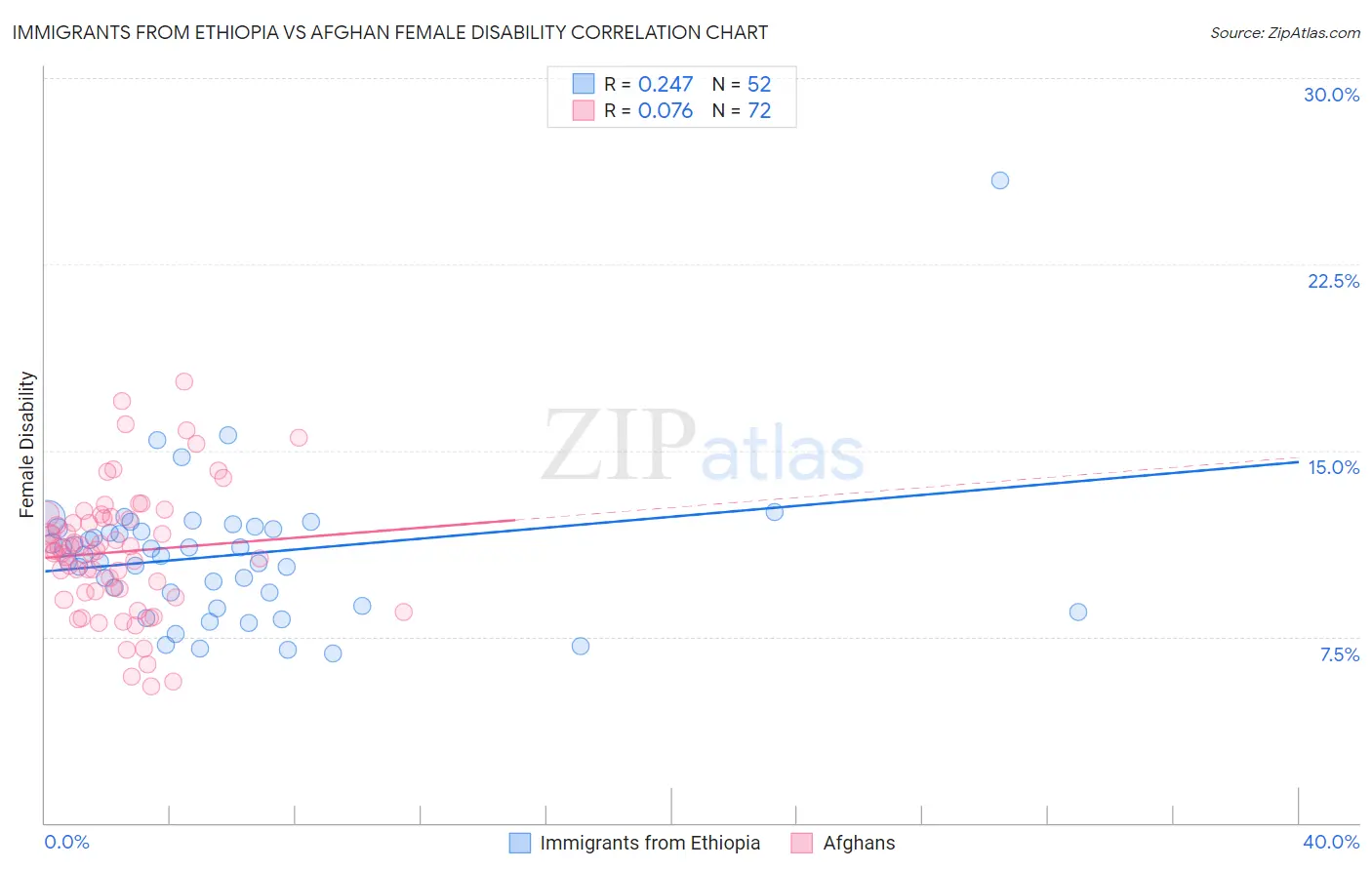Immigrants from Ethiopia vs Afghan Female Disability
COMPARE
Immigrants from Ethiopia
Afghan
Female Disability
Female Disability Comparison
Immigrants from Ethiopia
Afghans
11.2%
FEMALE DISABILITY
100.0/ 100
METRIC RATING
38th/ 347
METRIC RANK
11.2%
FEMALE DISABILITY
100.0/ 100
METRIC RATING
43rd/ 347
METRIC RANK
Immigrants from Ethiopia vs Afghan Female Disability Correlation Chart
The statistical analysis conducted on geographies consisting of 211,548,350 people shows a weak positive correlation between the proportion of Immigrants from Ethiopia and percentage of females with a disability in the United States with a correlation coefficient (R) of 0.247 and weighted average of 11.2%. Similarly, the statistical analysis conducted on geographies consisting of 148,868,441 people shows a slight positive correlation between the proportion of Afghans and percentage of females with a disability in the United States with a correlation coefficient (R) of 0.076 and weighted average of 11.2%, a difference of 0.38%.

Female Disability Correlation Summary
| Measurement | Immigrants from Ethiopia | Afghan |
| Minimum | 6.8% | 5.5% |
| Maximum | 25.9% | 17.8% |
| Range | 19.0% | 12.3% |
| Mean | 10.8% | 10.9% |
| Median | 10.8% | 11.0% |
| Interquartile 25% (IQ1) | 9.0% | 9.3% |
| Interquartile 75% (IQ3) | 11.9% | 12.3% |
| Interquartile Range (IQR) | 2.8% | 3.0% |
| Standard Deviation (Sample) | 2.9% | 2.6% |
| Standard Deviation (Population) | 2.9% | 2.6% |
Demographics Similar to Immigrants from Ethiopia and Afghans by Female Disability
In terms of female disability, the demographic groups most similar to Immigrants from Ethiopia are Ethiopian (11.2%, a difference of 0.030%), Cypriot (11.2%, a difference of 0.040%), Immigrants from Japan (11.2%, a difference of 0.11%), Immigrants from Lithuania (11.2%, a difference of 0.21%), and Mongolian (11.2%, a difference of 0.24%). Similarly, the demographic groups most similar to Afghans are Israeli (11.2%, a difference of 0.030%), Paraguayan (11.2%, a difference of 0.12%), Mongolian (11.2%, a difference of 0.14%), Immigrants from Lithuania (11.2%, a difference of 0.17%), and Cambodian (11.3%, a difference of 0.20%).
| Demographics | Rating | Rank | Female Disability |
| Turks | 100.0 /100 | #30 | Exceptional 11.1% |
| Immigrants | Kuwait | 100.0 /100 | #31 | Exceptional 11.1% |
| Immigrants | Australia | 100.0 /100 | #32 | Exceptional 11.1% |
| Immigrants | Egypt | 100.0 /100 | #33 | Exceptional 11.1% |
| Immigrants | Indonesia | 100.0 /100 | #34 | Exceptional 11.2% |
| Immigrants | Japan | 100.0 /100 | #35 | Exceptional 11.2% |
| Cypriots | 100.0 /100 | #36 | Exceptional 11.2% |
| Ethiopians | 100.0 /100 | #37 | Exceptional 11.2% |
| Immigrants | Ethiopia | 100.0 /100 | #38 | Exceptional 11.2% |
| Immigrants | Lithuania | 100.0 /100 | #39 | Exceptional 11.2% |
| Mongolians | 100.0 /100 | #40 | Exceptional 11.2% |
| Paraguayans | 100.0 /100 | #41 | Exceptional 11.2% |
| Israelis | 100.0 /100 | #42 | Exceptional 11.2% |
| Afghans | 100.0 /100 | #43 | Exceptional 11.2% |
| Cambodians | 100.0 /100 | #44 | Exceptional 11.3% |
| Immigrants | Sweden | 100.0 /100 | #45 | Exceptional 11.3% |
| Immigrants | Nepal | 100.0 /100 | #46 | Exceptional 11.3% |
| Jordanians | 100.0 /100 | #47 | Exceptional 11.3% |
| Zimbabweans | 100.0 /100 | #48 | Exceptional 11.3% |
| Tongans | 100.0 /100 | #49 | Exceptional 11.3% |
| Inupiat | 100.0 /100 | #50 | Exceptional 11.3% |